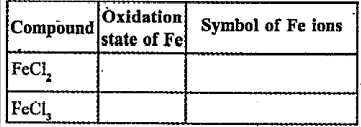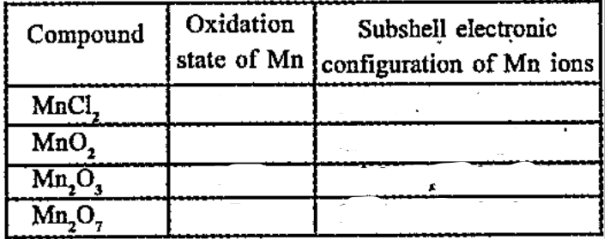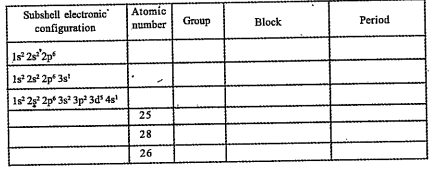Complete Solutions to EXAMPLE of chapter PEPIODIC TABLE AND ELECTRONIC CONFIGURATION of Class 10 book with complete answers and questions
| Class 10 | CHEMISTRY |
| Chapter | PEPIODIC TABLE AND ELECTRONIC CONFIGURATION |
| BODY BOOKS PUBLICATION | EXAMPLE |
| Number Of Questions | 100 |
| Academic Year | 2023-24 |
What is the basis of classification of elements in the periodic table?
View SolutionAtomic number of sodium is 11 Electronic configuration -2, 8, 1 Group Number -…………
View SolutionAtomic number of sodium is 11 Electronic configuration -2, 8, 1 Period number -…………..
View SolutionIs the group 1 element a metal or a non metal?
View SolutionWrite the electronic configuration of sodium and argon and complete the Table.
View SolutionHow many electrons are present in the M shell, the outermost shell of argon?
View SolutionWhat is the maximum number of electrons that can be accommodated in the M Shell?
View SolutionThe 'K' shell, which is the first shell, has 1 sinshell. The next 'L' shell has 2, and so on. What will be the number of subshells in the 'M' shell and 'N'. M=…………..,N=…………….
View SolutionWhich sbshell is common to all shells?
View SolutionWhat is the maximum number of electrons that can be accommodated in the `s` subshell?
View SolutionWhat is the maximum number of electrons that can be accommodated in the `p` subshell?
View SolutionHow many electrons are present in the M-shell of an element with atomic number 20?
A) 8
B) 6
C) 18
D) 2
View SolutionHow many electrons are present in helium `("_2He)`?
View SolutionComplete the subshell electronic configuration of He?
View SolutionWrite the electronic configuration of Lithium `("_3Li)`
View SolutionComplete the electronic configuration of beryllium?
View SolutionWrite the electronic configuration of Borom.
View SolutionWrite the electronic configuration of Carbon.
View SolutionWrite the electronic configuration of sodium and argon and complete the Table.
View SolutionHow was the shell wise electronic configu-ration of potassium written?
View SolutionCompare the energies of 1 s and 2 s subshells. Which one has lower energy?
View SolutionAmong the 3s & 3p subshells which has higher energy?
View SolutionAmong the 3d & 4s sushells which has higher energy?
View SolutionWrite down the subshells in the increasing order of their energies.
View SolutionWrite the subshell wise electronic configu-ration of potassium
View SolutionThe electronic configuration of scandium `("_21Sc)` is
View SolutionWrite the electronic configuration of `"22TI`, `"23V`, the two elements after Sc.
View SolutionWhich is the nobel gas preceding sodium `("11Na)`/
View SolutionWrite its subshell electronic configuration. (nobel gas preceding sodium)
View SolutionSubshell electronic configuration of sodium?
View SolutionUsing the symbol of neon, write the subshell electronic configuration of sodium?
View SolutionWhich element has a valency 1?
View SolutionWhich element shows metallic character?
Elements : X, Y
Atomic number: 12, 17 respectively.
View SolutionWhich element has the highest ionisation energy?
View SolutionWrite the chemcial formula of compound formed by the combination of X and Y and label the oxidation states?
View SolutionWhere is the position of d block elements in the periodic table?
View SolutionFrom which period onward does the d block begin?
View SolutionComplete the table 1.16

View SolutionHow does Fe change to `Fe^(2+)`?
View SolutionWrite down the subshell electronic config-uration of `Fe^(2+)`.
View SolutionIf so, which will be the subshel from which iron loses the third electron?
View SolutionWrite the electronic configuratoin of `Fe^(3+)`
View SolutionWrite the subshell electronic configuration of Manganese(Mn).
View SolutionComplete the table 1.17

View SolutionExamine these compounds availible. Find more coloured compounds and extend the list.
View SolutionWhich elements shows +2 oxidaion state?
View SolutionWhich elements contains 5 electrons in the outermost shell?
View SolutionWhich is the element that has 5 p electrons in the outermost shell?
View SolutionWhich are the elements in which the last electron enters the d subshell?
View SolutionWhich element has the highest ionisation energy?
View SolutionWhich is the highly reactive non metal?
View SolutionWhich elements shows -2 oxidaion state?
View Solution[Ar] 3d5 4s2 is the sub shell electronic configuration of an element.
Which is the element?
View Solution[Ar] 3d5 4s2 is the sub shell electronic configuration of an element.
Write down the complete subshell electronic configuration?
View Solution[Ar] 3d5 4s2 is the sub shell electronic configuration of an element.
Write any two characteristics of this element?
View SolutionWhen the last electron of an atom was filled in the 3d subshell, the subshell electronic configuration was recorded as `3d^8`. Answer the questions related to this atom. Complete subshell electronic config-uration, Atomic number, Block, Period number, Group number.
View SolutionPick out the wrong ones from the subshell electronic configuration given below: `1s^2 2s^2 2p^7`
View SolutionPick out the wrong ones from the subshell electronic configuration given below: `1s^2 2s^2 2p^2`
View SolutionPick out the wrong ones from the subshell electronic configuration given below: `1s^2 2s^2 2p^5 3s^1`
View SolutionPick out the wrong ones from the subshell electronic configuration given below: `1s^2 2s^2 2p^6 3s^2 3p^6 3d^2 4s^1`
View SolutionPick out the wrong ones from the subshell electronic configuration given below: `1s^2 2s^2 2p^6 3s^2 3p^6 3d^2 4s^2`
View SolutionThe element X in group 17 has 3 shells. If so: Write the subshell electronic configura-tion of the element.
View SolutionThe element X in group 17 has 3 shells. If so: Write the period number.
View SolutionThe element X in group 17 has 3 shells. If so: What will be the chemical formula of the compound formed if the element X reacts with element Y of the third period which contains one electron in the p subshell?
View SolutionThe element Cu with atomic number 29 undergoes chemcial reaction to formation with oxidation number +2: write down the subshell electronic con-figuration of the ion.
View SolutionThe element Cu with atomic number 29 undergoes chemcial reaction to formation with oxidation number +2: Can this element show variable valency? Why?
View SolutionThe element Cu with atomic number 29 undergoes chemcial reaction to formation with oxidation number +2: Write downthe chemical formula of one compound formed when this element re-acts with chlorine `("17CI)`.
View SolutionCertain subshells of an atom are given below. 2s,2d,3f,3d,5s,3p: Which are the subshells that are not possible? Give the reason.
View SolutionCertain subshells of an atom are given below. 2s,3d,3f,4d,5s,3p: Which are the subshells that are not possible? Give the reason.
View SolutionPrepare the comprehensive table which indicates the name, symbol, electron configuration, subshell configuration of elements having atomic number 1 to 36?
View SolutionSome information related to the elements of the p block in the 17th group of the periodic table are given in the table below. Complete the able and analyse the following questions.
a) What is the family name of element belonging to 17th group?
b) what is their common valency?
c) Which element has the highest electronegativity?
d) Which element has highest ionisation energy?
e) List out the name and chemical formula of the compounds formed by this elements with s block elements.
'(##VPU_TTT_CHE_X_P01_C01_E02_002_Q01##)'
View SolutionWhat is the family names of elements be-longing to the 17 th group?
View SolutionWhat is the common valency of elements be-longing to the 17 th group?
View SolutionWhich element has the highest electronega-tivity in 17th group?
View SolutionWhich element has the highest ionisation energy?
View SolutionList out the name and chemcial formula of the compound formed by this elements Halogen Family with s block elements?
View SolutionWhat are shells and subshells.
View SolutionNo of electrons in KLMN shell.
View SolutionNo of electrons present in in the 3rd shell.
View SolutionWhich sbshell is common to all shells?
View SolutionWrite names of subshells in accordance with increasing energy level.
View SolutionIdentify the incorrect subshell electronic configuration.
View SolutionAtomic number of iron is 26. It exhibits `Fe^(2+)`, `Fe^(3+)` oxidation state. Write the subshell elec-tronic configuration.
View SolutionMagnanese, a d-block elements exhibits different oxidation state.Why?
View SolutionWrite the oxidation number and subshell electronic configuration K, CI and O.
View SolutionFind out atomic number,group, block period using subshell electronic configuration and then complete the table.

View SolutionWrite down the characteristics of s,d,p,f block elements.
View SolutionWrite down subshell electronic configura-tion of `Cu^(1+)` and `Cu^(2+)`
View SolutionHow many 's' subshell electrons are present in `1s^2, 2s^2, 2p^6, 3s^2, 3p^2`
View Solution11,17,10 are the atomic number of elements X,Y and Z: Write down their subshell electronic configuration, group, block, period.
View Solution11,17,10 are the atomic number of elements X,Y and Z: Write the molecular formulac of the compound formed when any two of the above elements are combined.
View Solution11,17,10 are the atomic number of elements X,Y and Z: Write down the oxidation numbers of the elements in the compound formed by any two of the element. Write the subshell electronic configuration of both ions.
View SolutionElement 'X' is having atomic number 28, it gives two electrons to element 'Y': Write down the electronic configuration of 'X' and its ion.
View SolutionElement 'X' is having atomic number 28, it gives two electrons to element 'Y': In which block 'X' belongs?
View SolutionElement 'X' is having atomic number 28, it gives two electrons to element 'Y': Write down the characteristics of that block.
View Solution
Write down the group and period of each element.
View Solution
 What are the use of writing electronic configuration this fashion?
What are the use of writing electronic configuration this fashion?
View Solution`"_24Cr-[Ar]3d^5 4s^1` Why chromium exhibits such electronic configuration?
View Solution`"_29Cu-[Ar]3d^10 4s^1` Why chromium and copper exhibits such electronic configuration?
View SolutionThe electronic configuration of the elements are given below.
A-`1s^2 2s^2 2p^6 3s^2 3p^4`
B-`1s^2 2s^2 2p^6 3s^2`
C-`1s^2 2s^2 2p^6 3s^2 3p^5`
D-`1s^2 2s^2 2p^6 3s^1` Which of these elements show +2 oxida-tion state?
View Solution
EXAMPLE questions and complete solutions for chapter PEPIODIC TABLE AND ELECTRONIC CONFIGURATION of BODY BOOKS PUBLICATION of Class 10